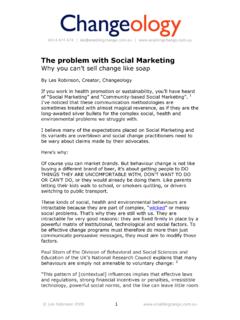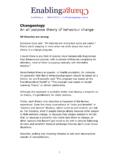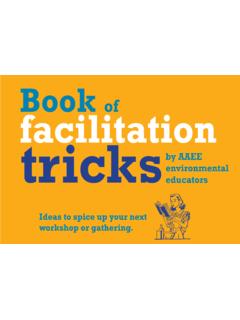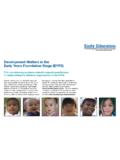Transcription of How to make a theory of change - Enabling Change
1 1 Les Robinson Phone 0414 674 676 How to make a theory of Change Introducing a collaborative method for designing solutions to complex social and environmental problems (v2 Aug 09) The challenge of intractable problems (skip to the method if you want) One obstacle to effective government is fantastic ideas . Everyone has them and they are all fantastic. The problem is: when faced with a seemingly intractable problem like, say, a polluted river or a dysfunctional community, 10 people will have 10 different fantastic ideas.
2 So which one should you go with? The smartest , the most innovative , the pet project of the most powerful person, or the cheapest,? And there is, of course, the possibility that every one of those 10 ideas is half baked. Why might that be so? Because we all carry in our heads uncritical assumptions about what it takes to Change the behaviour of others. These lay theories of Change often tell us more about personal prejudices and organizational blind spots than they do about the unique realities of the people we hope to influence.
3 Examples of simplistic lay theories of Change include assumptions that people will Change their behaviour when they get the right information; they get the right message; they get the right incentives; they get the right threats and punishments, or when they get the right services. However when the evidence is examined dispassionately it turns out that none of these theories has a particularly strong claim to effectiveness. The challenge is to replace uncritical assumptions with more nuanced and adaptive theories of Change which closely fit the unique realities of real people leading real lives in the real world.
4 Enabling Change 2 The difficulty, however, is that intractable social, health and environmental problems are outrageously complex. They are the result of myriad poorly understood forces operating over great scales of time and space with politics and power never far below the surface. Their context is not just the individual but often broad social and institutional systems. Even defining a problem can involve uncertainty, conflict, ideology, power games and turf wars. Solving complex problems is not like building bridges, doing accounting, or performing chemical experiments.
5 There is never one best way. In fact, there may be no best way. Your program might, for instance, have to start as a series of experiments with uncertain outcomes, some worth building on, others not. And then there is the human element. Every Change program is a people Change program. Success will depend on people leaving their comfort zones. No matter how fantastic your idea is, people will still need to believe in it, believe the risks are worth it, invest their passion, time and resources in it, and sustain their investment over many years.
6 Experience tells us that this only happens when people have a hand in designing the program from the start. And then there is entropy. You can t go backwards in time. Removing the causes of a problem is rarely an option. A community can t go backwards to a state of nature where there is no alcohol, TV, pornography, junk food or sexually transmitted diseases. A river valley can t go backwards to a natural state where there is no agriculture, forestry or irrigation. Hence the focus on the problem found many analytic models (like as DIPSR and PRECEDE, for example) is not as helpful as it seems.
7 The time and energy spent studying a problem may be better spent learning about (and being inspired by) other people s success in increasing the resilience of communities and institutions. As a facilitator and trainer in Change programs I faced a challenge. I needed a method of designing Change programs that was suited to tackling complex social and environmental problems. I wanted one that could mobilise and process the contributions of diverse participants, that was scalable from small to large programs, that was outward looking and encouraged imagination, and that was enjoyable and simple so time-poor professionals could actually do it.
8 I this paper I m sharing a process that s been evolved and tested in a many workshops over the last few years. I believe it provides a relatively simple, quick, engaging way to develop richly nuanced programs in complex, uncertain settings. Enabling Change 3 You could use this as part of the full collaborative design cycle described in CoCreate manual on my website, or use it to develop a smaller one-off Change program. How the method evolved I began by using a simple team brainstorm captured on a mud-map, with the focus question what s causing the problem.
9 However the results tended to be shallow (they had low analytic value). Then I experimented with the Ishikawa diagram. It had similar problems. Then I discovered the Problem Tree method used by AusAid (also called the Cause and Effect Tree or Five Whys ). It s analytically rich because it forces participants to look at the forces behind the symptoms, and the forces behind those forces and so on. However I found it had two weaknesses. First, it was hard to explain and required a surprising amount of practice and discipline to do well (I noticed participants spent a lot of time simply perplexed, despite my best efforts to explain the process).
10 Secondly, it was negative: it focused on problems. Solutions, by contrast, need to be acts of imagination which can t be generated by studying problems alone. In fact I often found participants were so demoralized by focusing on their problems that they couldn t come up with any positive ideas at all. Which isn t to say the Problem Tree method doesn t work. It does and it s an effective system. But I wanted something easier, quicker, more engaging and more inspiring. First, I chose a simpler method an oldy and a goody the Force Field method.








